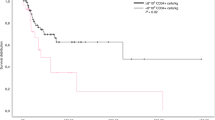Abstract
The availability of hematopoietic growth factors has greatly facilitated the mobilization and collection of peripheral blood stem cells (PBSC). It was the aim of this double-blind study to compare the PBSC-mobilizing efficacy of recombinant human G-CSF and GM-CSF when administered post-chemotherapy. Twenty-six patients with relapsed Hodgkin’s disease were included in the study. Their median age was 31 years (range, 22–59) and 14 patients were males and 12 were females. Patients were pretreated with a median of eight cycles of cytotoxic chemotherapy, while 18 patients had undergone extended field irradiation. The patients received dexamethasone 24 mg days 1–7, melphalan 30 mg/m2 day 3, BCNU 60 mg/m2 day 3, etoposide 75 mg/m2 days 4–7, Ara-C 100 mg/m2 twice daily days 4–7 (Dexa-BEAM). Twelve patients were randomized to receive 5 μg/kg/day G-CSF and 14 patients to receive 5 μg/kg/day GM-CSF, both administered subcutaneously starting on day 1 after the end of Dexa-BEAM. Primary endpoints of the study were the number of CD34+ cells harvested per kg body weight on the occasion of six consecutive leukaphereses and the time needed for hematological reconstitution following autografting. Twenty-one patients completed PBSC collection, and six patients of the G-CSF group and nine of the GM-CSF group were autografted. No difference was observed with respect to the median yield of CFU-GM and CD34+ cells: 32.5 × 104/kg vs 31.3 × 104/kg CFU-GM, and 7.6 × 106/kg vs 5.6 × 106/kg CD34+ cells, for G-CSF and GM-CSF, respectively (U test, P = 0.837 and 0.696). High-dose chemotherapy consisted of cyclophosphamide 1.7 g/m2 days 1–4, BCNU 150 mg/m2 days 1–4, etoposide 400 mg/m2 days 1–4. All patients transplanted with more than 5 × 106 CD34+ cells/kg had a rapid platelet recovery (20 × 109/l) between 6 and 11 days and neutrophil recovery (0.5 × 109/l) between 9 and 16 days, while patients transplanted with less than 5 × 106/kg had a delayed reconstitution, regardless of the kind of growth factor used for PBSC mobilization. In conclusion, our data indicate that in patients with Hodgkin’s disease G-CSF and GM-CSF given after salvage chemotherapy appear to be not different in their ability to mobilize PBSC resulting in a similar time needed for hematological reconstitution when autografted following high-dose therapy.
Similar content being viewed by others
Author information
Authors and Affiliations
Rights and permissions
About this article
Cite this article
Hohaus, S., Martin, H., Wassmann, B. et al. Recombinant human granulocyte and granulocyte–macrophage colony-stimulating factor (G-CSF and GM-CSF) administered following cytotoxic chemotherapy have a similar ability to mobilize peripheral blood stem cells. Bone Marrow Transplant 22, 625–630 (1998). https://doi.org/10.1038/sj.bmt.1701422
Received:
Accepted:
Published:
Issue Date:
DOI: https://doi.org/10.1038/sj.bmt.1701422
- Springer Nature Limited
Keywords
This article is cited by
-
Efficacy of hematopoietic stem cell mobilization regimens in patients with hematological malignancies: a systematic review and network meta-analysis of randomized controlled trials
Stem Cell Research & Therapy (2022)
-
Mobilization, harvesting and selection of peripheral blood stem cells in patients with autoimmune diseases undergoing autologous hematopoietic stem cell transplantation
Bone Marrow Transplantation (2007)
-
Low doses of GM-CSF (molgramostim) and G-CSF (filgrastim) after cyclophosphamide (4 g/m2) enhance the peripheral blood progenitor cell harvest: results of two randomized studies including 120 patients
Bone Marrow Transplantation (2006)
-
Colony-stimulating factors in the management of neutropenia and its complications
Annals of Hematology (2005)
-
Homing and mobilization of hematopoietic stem cells and hematopoietic cancer cells are mirror image processes, utilizing similar signaling pathways and occurring concurrently: circulating cancer cells constitute an ideal target for concurrent treatment with chemotherapy and antilineage-specific antibodies
Leukemia (2004)




